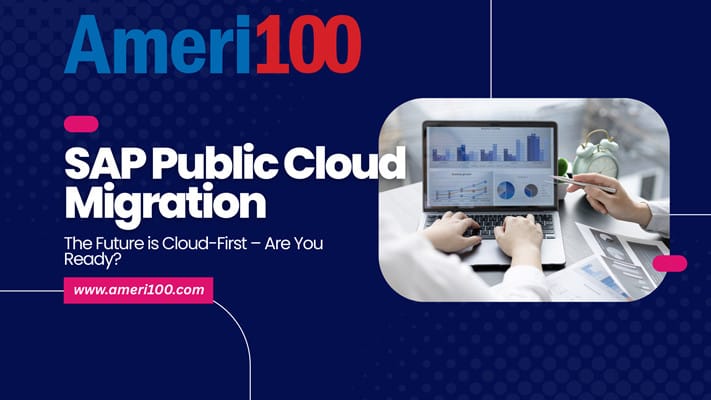The Future is Cloud-First – Are You Ready?
If your SAP systems remain on-premises, it’s time to change. As SAP’s 2027 cut-off date for mainstream support for Business Suite 7 approaches, companies are increasingly under pressure to transition to SAP S/4HANA.
While going private cloud is possible, the SAP Public Cloud provides more agility, scalability, and ongoing innovation—all without the headache of infrastructure management.
It’s a process of transformation requiring careful planning and execution. Your strategic guide on how to get it right:
- Analyze Your Current SAP Landscape
You can’t plan the move until you understand what you’re working with. Inventory your current SAP systems: ERP, BW, CRM, or custom.
Know how your business is using them, their dependencies, and degree of customization. Run a cloud readiness assessment to identify potential challenges. This includes workload analysis, data evaluation, and a customization audit. Tools like SAP Readiness Check can flag compatibility issues and recommend fixes.
2. Define the Business Case
Cloud migration is a major investment, so you will need a compelling business case to secure leadership buy-in. This goes beyond just cutting infrastructure costs—it’s about enabling faster decision-making, real-time insights, and improved scalability.
For instance, businesses moving to SAP Public Cloud tend to decrease infrastructure expenses by 30-50% while increasing operational efficiency. Chart out the concrete benefits for your business, e.g., streamlined processes, improved reporting, or accelerated innovation cycles.
- Select the Appropriate Migration Strategy
There are three broad strategies for SAP cloud migration:
- Greenfield (Start from Scratch): Full re-implementation on SAP S/4HANA Public Cloud. Best suited for firms looking for process modernization and less legacy baggage.
- Brownfield (System Conversion): Converts your current ECC system with existing configurations. Quicker but less transformative.
- Hybrid (Selective Transition): A combination of the two. You transition key processes while re-engineering others. This phased method reduces risk.
The ideal approach is based on your existing landscape, business objectives, and time horizon. Most businesses prefer doing phased migrations, beginning with less important workloads prior to addressing core systems.
- Clean and Optimize Your Data
Migrating dirty data is costly and adds complexity. Classify your data prior to migration. Determine what should be migrated, archived, or retired. Execute data cleansing activities to eliminate duplicates, outdated records, and irrelevant data. This minimizes the footprint of data and maximizes performance in the cloud.
- Choose the Proper Cloud Provider
SAP Public Cloud runs on hyperscalers like Microsoft Azure, AWS, and Google Cloud. All have various capabilities, cost structures, and geographic footprints.
In selecting a provider, your business might want to consider scalability, security, and compliance. If you need a one-stop shop, RISE with SAP combines S/4HANA Cloud, hosting, and managed services in one package—making the migration easier.
6. Emphasize Security and Compliance
Cloud migration poses new security threats. Your business will require strong access controls, encryption methods, and backup procedures.
Comply with industry standards such as GDPR, HIPAA, or SOC 2, based on your geographical location and industry. Have continuous security monitoring in place to protect your data.
7. Develop a Change Management Plan
Cloud migration is not technology alone—it’s people. Without proper change management, you are at risk of poor adoption and business disruption.
Explain the benefits early and clearly. Train employees on the new processes and tools. Ensure ongoing support for a seamless transition.
- Test, Optimize, and Monitor
After migrating, careful testing is critical. Conduct performance and user acceptance testing (UAT) to ensure business processes.
After migration, observe system performance with SAP Cloud ALM or third-party solutions. Tuning configurations for maximum speed and efficiency.
The Cloud Is Just the Beginning
Migrating to SAP Public Cloud isn’t just about keeping up—it’s about unlocking new levels of agility and innovation. With the right strategy, you’ll reduce costs, streamline operations, and gain the flexibility to scale as your business grows.
The key is to plan carefully, migrate strategically, and optimize continuously. Done right, your SAP cloud journey will position your organization for long-term success.
As a leading SAP solutions provider, Ameri100 brings deep expertise and proven methodologies to guide you through every stage of your cloud migration. Our team of certified SAP consultants, cloud architects, and data specialists has successfully helped enterprises:
- Accelerate migration timelines with structured, risk-mitigated approaches.
- Optimize workloads for cloud-native performance and cost efficiency.
- Ensure business continuity with seamless integrations and minimal downtime.
- Drive post-migration value through continuous optimization and support.
Ready to future-proof your SAP environment? Let Ameri100 walk you through each phase of the migration process – from strategy and implementation to optimization and beyond. Contact us today and begin making your cloud dreams a reality.
Email us: [email protected]
Website: www.ameri100.com

